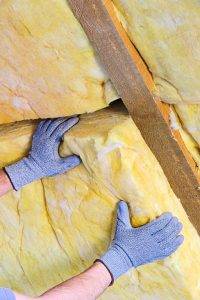As important as insulation is to your home performance and the performance of your heating and air-conditioning system, many homeowners struggle with understanding insulation terms. In fact, insulation is probably one of the least understand factors in the performance of your home. Let’s face it, when was the last time you wandered around in your attic—and dragging down the holiday decorations doesn’t count. When was the last time you took a close look at the insulation in your crawlspace, basement or attic? Do you even know if you have enough insulation? Chances are, you don’t.
 Big Fuzzy Blanket
Insulation is like a big, fuzzy blanket that keeps your home protected throughout the year. In the winter, insulation keeps the heat from your furnace inside your home, where you want it, while in the summer it keeps that Texas heat outside. The important part about this big fuzzy blanket is that you want it to be like the down comforter on your grandmother’s bed, not that tattered old blankie you carried around as toddler. Understanding insulation terms can help you be sure that you have the proper protection from the summer heat and the winter freeze.
What is R-Value?
One of the most critical insulation terms to understand is R-Value, as the “R” stands for “resistance.” The main purpose of insulation is to resist the transfer of heat, so the higher the R-Value the more heat resistant the insulation. In the Dallas-Fort Worth area, older attics often have a rating between R-2 and R-4 per inch. For the math challenged out there, that means that if your insulation is even with the top of your ceiling joist, you probably have about R-10 of attic insulation. This sounds pretty good until you understand that current building codes require an R-Value of R-38, which is about 14 inches of insulation, depending on the type of insulation used. However, running out and buying insulation and throwing it over the attic floor should not be the first step in properly insulating your home.
Questions to Ask
Before adding new insulation, it is important to ask a few questions related to insulation terms. Insulation should be clean, so check to be sure that rodents, pests or that roofer your brother-in-law recommended has not contaminated the current insulation. You need to be sure there are no air leaks between the living space and the attic, as you may need to caulk or use weather stripping to correct those leaks before adding insulation. An inspection of the electrical system in the attic is recommended before adding insulation, as is checking the ductwork for needed repairs or replacement. Finally, be sure your attic is ventilated properly. A qualified HVAC technician from Spencer AC & Heating can answer all of these questions for you.
If you want more information about insulation terms, or feel you do not have adequate insulation in your home, visit Spencer AC & Heating online, and be sure to connect with us on Twitter, Facebook, YouTube and LinkedIn!
Big Fuzzy Blanket
Insulation is like a big, fuzzy blanket that keeps your home protected throughout the year. In the winter, insulation keeps the heat from your furnace inside your home, where you want it, while in the summer it keeps that Texas heat outside. The important part about this big fuzzy blanket is that you want it to be like the down comforter on your grandmother’s bed, not that tattered old blankie you carried around as toddler. Understanding insulation terms can help you be sure that you have the proper protection from the summer heat and the winter freeze.
What is R-Value?
One of the most critical insulation terms to understand is R-Value, as the “R” stands for “resistance.” The main purpose of insulation is to resist the transfer of heat, so the higher the R-Value the more heat resistant the insulation. In the Dallas-Fort Worth area, older attics often have a rating between R-2 and R-4 per inch. For the math challenged out there, that means that if your insulation is even with the top of your ceiling joist, you probably have about R-10 of attic insulation. This sounds pretty good until you understand that current building codes require an R-Value of R-38, which is about 14 inches of insulation, depending on the type of insulation used. However, running out and buying insulation and throwing it over the attic floor should not be the first step in properly insulating your home.
Questions to Ask
Before adding new insulation, it is important to ask a few questions related to insulation terms. Insulation should be clean, so check to be sure that rodents, pests or that roofer your brother-in-law recommended has not contaminated the current insulation. You need to be sure there are no air leaks between the living space and the attic, as you may need to caulk or use weather stripping to correct those leaks before adding insulation. An inspection of the electrical system in the attic is recommended before adding insulation, as is checking the ductwork for needed repairs or replacement. Finally, be sure your attic is ventilated properly. A qualified HVAC technician from Spencer AC & Heating can answer all of these questions for you.
If you want more information about insulation terms, or feel you do not have adequate insulation in your home, visit Spencer AC & Heating online, and be sure to connect with us on Twitter, Facebook, YouTube and LinkedIn!
 Big Fuzzy Blanket
Insulation is like a big, fuzzy blanket that keeps your home protected throughout the year. In the winter, insulation keeps the heat from your furnace inside your home, where you want it, while in the summer it keeps that Texas heat outside. The important part about this big fuzzy blanket is that you want it to be like the down comforter on your grandmother’s bed, not that tattered old blankie you carried around as toddler. Understanding insulation terms can help you be sure that you have the proper protection from the summer heat and the winter freeze.
What is R-Value?
One of the most critical insulation terms to understand is R-Value, as the “R” stands for “resistance.” The main purpose of insulation is to resist the transfer of heat, so the higher the R-Value the more heat resistant the insulation. In the Dallas-Fort Worth area, older attics often have a rating between R-2 and R-4 per inch. For the math challenged out there, that means that if your insulation is even with the top of your ceiling joist, you probably have about R-10 of attic insulation. This sounds pretty good until you understand that current building codes require an R-Value of R-38, which is about 14 inches of insulation, depending on the type of insulation used. However, running out and buying insulation and throwing it over the attic floor should not be the first step in properly insulating your home.
Questions to Ask
Before adding new insulation, it is important to ask a few questions related to insulation terms. Insulation should be clean, so check to be sure that rodents, pests or that roofer your brother-in-law recommended has not contaminated the current insulation. You need to be sure there are no air leaks between the living space and the attic, as you may need to caulk or use weather stripping to correct those leaks before adding insulation. An inspection of the electrical system in the attic is recommended before adding insulation, as is checking the ductwork for needed repairs or replacement. Finally, be sure your attic is ventilated properly. A qualified HVAC technician from Spencer AC & Heating can answer all of these questions for you.
If you want more information about insulation terms, or feel you do not have adequate insulation in your home, visit Spencer AC & Heating online, and be sure to connect with us on Twitter, Facebook, YouTube and LinkedIn!
Big Fuzzy Blanket
Insulation is like a big, fuzzy blanket that keeps your home protected throughout the year. In the winter, insulation keeps the heat from your furnace inside your home, where you want it, while in the summer it keeps that Texas heat outside. The important part about this big fuzzy blanket is that you want it to be like the down comforter on your grandmother’s bed, not that tattered old blankie you carried around as toddler. Understanding insulation terms can help you be sure that you have the proper protection from the summer heat and the winter freeze.
What is R-Value?
One of the most critical insulation terms to understand is R-Value, as the “R” stands for “resistance.” The main purpose of insulation is to resist the transfer of heat, so the higher the R-Value the more heat resistant the insulation. In the Dallas-Fort Worth area, older attics often have a rating between R-2 and R-4 per inch. For the math challenged out there, that means that if your insulation is even with the top of your ceiling joist, you probably have about R-10 of attic insulation. This sounds pretty good until you understand that current building codes require an R-Value of R-38, which is about 14 inches of insulation, depending on the type of insulation used. However, running out and buying insulation and throwing it over the attic floor should not be the first step in properly insulating your home.
Questions to Ask
Before adding new insulation, it is important to ask a few questions related to insulation terms. Insulation should be clean, so check to be sure that rodents, pests or that roofer your brother-in-law recommended has not contaminated the current insulation. You need to be sure there are no air leaks between the living space and the attic, as you may need to caulk or use weather stripping to correct those leaks before adding insulation. An inspection of the electrical system in the attic is recommended before adding insulation, as is checking the ductwork for needed repairs or replacement. Finally, be sure your attic is ventilated properly. A qualified HVAC technician from Spencer AC & Heating can answer all of these questions for you.
If you want more information about insulation terms, or feel you do not have adequate insulation in your home, visit Spencer AC & Heating online, and be sure to connect with us on Twitter, Facebook, YouTube and LinkedIn! 



